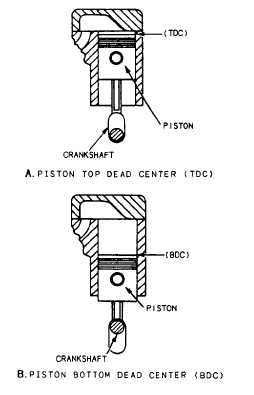enters the cylinder, it ignites. Figure 7-2 shows the
comparison of the four strokes of four-cycle diesel
and gasoline engines.
The speed of a diesel or gasoline engine is
controlled by the amount of fuel-air mixture that
is burned in the cylinders. The primary difference
is the method in which the fuel and air enter the
combustion chamber. In a diesel engine, the fuel
is injected directly into the combustion chamber,
where it mixes with air. In a gasoline engine, the
fuel and air are mixed in the intake manifold and
then drawn into the combustion chamber.
Mechanically, the diesel engine is similar to
the gasoline engine. The intake, compression,
power, and exhaust strokes occur in the same
order. The arrangement of the pistons, connecting
rods, crankshaft, and engine valves are also the
same.
DEVELOPMENT OF POWER
The power of an internal-combustion engine
comes from the burning of a mixture of fuel and
air in a small, enclosed space. When this mixture
burns, it expands greatly. The push or pressure
created is used to move the piston. The piston then
rotates the crankshaft. The rotating crankshaft
is then used to perform the desired work.
Since the same actions occur in all cylinders
of an engine, we will discuss only one cylinder and
its related parts. The four major parts consist of
a cylinder, piston, crankshaft, and connecting rod
(fig. 7-1).
First we must have a cylinder that is closed
at one end. The cylinder is stationary within the
engine block.
Inside this cylinder is the piston (a movable
metal plug) that fits snugly into the cylinder but
can still slide up and down easily. Movement of
the piston is caused by the burning fuel-air
mixture in the cylinder.
You have already learned that the back-and-
forth movement of the piston is called recipro-
cating motion, which must be changed to rotary
motion. This change is accomplished by a throw
on the crankshaft and a connecting rod that
connects the piston and the crank throw.
The number of piston strokes occurring
during any one series of operations (cycles) is
limited to either two or four, depending on the
design of the engine.
When the piston of the engine slides down-
ward because of the pressure of the expanding
gases in the cylinder, the upper end of the
Figure 7-3.—Piston stroke.
connecting rod moves downward with the piston
in a straight line. The lower end of the connecting
rod moves down and in a circular motion at the
same time. This moves the crank throw and, in
turn, rotates the shaft. This rotation is the
desired result. So remember, the crankshaft and
connecting rod combination is a mechanism for
the purpose of changing back-and-forth (recipro-
cating) motion to circular (rotary) motion.
BASIC ENGINE STROKES
Each movement of the piston from top to
bottom or from bottom to top is called a stroke.
The piston takes two strokes (an upstroke and
a downstroke) as the crankshaft makes one
complete revolution. When the piston is at the top
of a stroke (fig. 7-3, view A), it is said to be at
top dead center (TDC). When the piston is at the
bottom of a stroke (fig. 7-3, view B), it is said
to be at bottom dead center (BDC).
In the basic engine you have studied so far,
we have not considered provisions for getting the
fuel-air mixture into the cylinder or burned gases
out of the cylinder. There are two openings in the
enclosed end of a cylinder. One of the openings,
7-3


